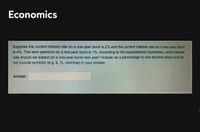
ENGR.ECONOMIC ANALYSIS
14th Edition
ISBN: 9780190931919
Author: NEWNAN
Publisher: Oxford University Press
expand_more
expand_more
format_list_bulleted
Question

Transcribed Image Text:Economics
Suppose the current interest rate on a one-year bond is 2% and the current interest rate on a two-year bond
is 4%. The term premium on a two-year bond is 1%. According to the expectations hypothesis, what interest
rate should we expect on a one-year bond next year? Answer as a percentage to one decimal place and do
not include symbols (e.g. $, %, commas) in your answer.
Answer:
Expert Solution
This question has been solved!
Explore an expertly crafted, step-by-step solution for a thorough understanding of key concepts.
Step by stepSolved in 3 steps with 1 images

Knowledge Booster
Learn more about
Need a deep-dive on the concept behind this application? Look no further. Learn more about this topic, economics and related others by exploring similar questions and additional content below.Similar questions
- The table below shows current and expected future one-year interest rates, as well as current interest rates on multiyear bonds. Use the table to calculate the liquidity premium for each multiyear bond. One-Year Bond Year Rate 1 2.00% 2 4.00% 3 5.00% 4 8.00% 5 11.00% Multiyear Bond Rate 2.00% 5.00% 7.00% 9.00% 10.00% The liquidity premiums for each year are given as: (Enter your responses rounded to two decimal places.) 11 = 0% 21 = 131 = 55 141 = = % do do do do % % %arrow_forwardSuppose your company is in equilibrium, with its capital stock at its desired level. A permanent decline in the expected real interest rate now has what effect on your desired capital stock? Use relevant diagrams to answer. (Assume a closed economy unless stated otherwise)arrow_forwardLet's denote the price of a nonmaturing bond (called a consol) as P. The equation that indicates this price is P, =-, where I is the annual net income the bond generates and r is the nominal market interest rate. a. Suppose that a bond promises the holder $200 per year forever. The nominal market interest rate is 6 percent. Calculate the bond's current price: $ 3333. (Round your answer to the nearest whole dollar.) b. Calculate the bond's price, if the market interest rate increases to 12 percent: $. (Round your answer to the nearest whole dollar.)arrow_forward
- Which of the following is a true statement? Multiple Choice ___ If interest rates fall, U.S. Treasury bonds will have decreasing values. ___ If interest rates fall, corporate bonds will have decreasing values. ___ If interest rates fall, no bonds will enjoy rising values. ___ If interest rates fall, all bonds will enjoy rising valuesarrow_forwardAssume i=0%, beta=1. Consumer has income of 80 in year 1, 100 in year 2. Now suppose gov't gives consumers a free check of 10 in year 1. Suppose consumers are naive (they don't anticipate the free check is financed by borrowing from China, which needs to be paid back through more tax in period 2), consumer will consume ____ in year 1. Hint: when consumers are naive, they will believe they have 80+10=90 income in period 1, and 100 income in period 2.arrow_forwardSuppose the current annual interest rate on a one-year government bond is 8% and the expected annual interest rate on a one-year bond one year from now is 8.5%, and a one- year bond two years from now is 9%. Based on this information, the current annual interest rate on a three-year government bond is approximately, A. 8.0% B. 9.0% 8.5% D. 8.2% 10% ABCDE C. E.arrow_forward
- Suppose the U.S. economy was at trend and now benefits from a boom in Asia, which raises de by 0.015. All other demand parameters remain unchanged. In order to maintain Y₁ = 0, the Federal Reserve raises the real interest rate R by 0.6 percentage point. Based on this information you know that b =arrow_forwardDescribe the emphasis that the neoclassical perspective takes on the macroeconomy, relative to the Keynesian perspective (Chapter 12). Discuss the importance of capital per person and the role of flexible prices in their perspective. What role do rational or adaptive expectations play in flexible prices? (13.1)arrow_forward
arrow_back_ios
arrow_forward_ios
Recommended textbooks for you

 Principles of Economics (12th Edition)EconomicsISBN:9780134078779Author:Karl E. Case, Ray C. Fair, Sharon E. OsterPublisher:PEARSON
Principles of Economics (12th Edition)EconomicsISBN:9780134078779Author:Karl E. Case, Ray C. Fair, Sharon E. OsterPublisher:PEARSON Engineering Economy (17th Edition)EconomicsISBN:9780134870069Author:William G. Sullivan, Elin M. Wicks, C. Patrick KoellingPublisher:PEARSON
Engineering Economy (17th Edition)EconomicsISBN:9780134870069Author:William G. Sullivan, Elin M. Wicks, C. Patrick KoellingPublisher:PEARSON Principles of Economics (MindTap Course List)EconomicsISBN:9781305585126Author:N. Gregory MankiwPublisher:Cengage Learning
Principles of Economics (MindTap Course List)EconomicsISBN:9781305585126Author:N. Gregory MankiwPublisher:Cengage Learning Managerial Economics: A Problem Solving ApproachEconomicsISBN:9781337106665Author:Luke M. Froeb, Brian T. McCann, Michael R. Ward, Mike ShorPublisher:Cengage Learning
Managerial Economics: A Problem Solving ApproachEconomicsISBN:9781337106665Author:Luke M. Froeb, Brian T. McCann, Michael R. Ward, Mike ShorPublisher:Cengage Learning Managerial Economics & Business Strategy (Mcgraw-...EconomicsISBN:9781259290619Author:Michael Baye, Jeff PrincePublisher:McGraw-Hill Education
Managerial Economics & Business Strategy (Mcgraw-...EconomicsISBN:9781259290619Author:Michael Baye, Jeff PrincePublisher:McGraw-Hill Education


Principles of Economics (12th Edition)
Economics
ISBN:9780134078779
Author:Karl E. Case, Ray C. Fair, Sharon E. Oster
Publisher:PEARSON

Engineering Economy (17th Edition)
Economics
ISBN:9780134870069
Author:William G. Sullivan, Elin M. Wicks, C. Patrick Koelling
Publisher:PEARSON

Principles of Economics (MindTap Course List)
Economics
ISBN:9781305585126
Author:N. Gregory Mankiw
Publisher:Cengage Learning

Managerial Economics: A Problem Solving Approach
Economics
ISBN:9781337106665
Author:Luke M. Froeb, Brian T. McCann, Michael R. Ward, Mike Shor
Publisher:Cengage Learning

Managerial Economics & Business Strategy (Mcgraw-...
Economics
ISBN:9781259290619
Author:Michael Baye, Jeff Prince
Publisher:McGraw-Hill Education